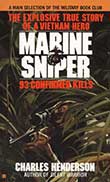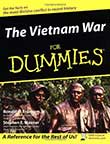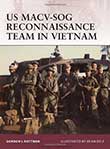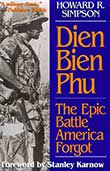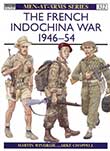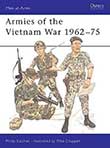

Sometimes truth really is stranger than fiction. The life of Carlos N. Hathcock II reads like the plot summary of a summer block buster movie. Hathcock resurrected the shunned and despised art of sniping and held off an entire company of enemy soldiers for five days with only the assistance of his spotter. He infiltrated deep behind enemy lines to assassinate an enemy commander with a single shot and then escaped undetected. Later, he sacrificed his life and body to save his fellow soldiers. He was feared and respected by his comrades and adversaries alike, he never gave up and fought incredible odds time and again and each time surmounted them.
The events are all true, despite the sensational sound of them. Marine Sniper: 93 Confirmed Kills is a biography of a two times Vietnam War veteran who, despite the extraordinary and dangerous path his life took, didn’t succumb to gun fire, mines, bombs or knives. In the end, frustrated at a body that could no longer do the things he loved to do, confined to wheelchairs and hospital beds, Carlos Hathcock died of multiple sclerosis twenty years after he was unable to serve his country as a Marine any more, and after twenty years of distinguished service.
Marine Sniper: 93 Confirmed Kills follows Hathcock’s life from his enrolment in to the Marine Corps at the age of 17 through to a little after his forced retirement at the age of 37. For the most part, it is an enjoyable read and, although biographical, still manages to incorporate large doses of suspense and conflict.
The Vietnam War was unlike any war the United States ever fought. Unlike the previous wars of the twentieth century, the Vietnam War left the United States divided, and it continues to influence U.S. domestic and foreign policy. Without question, the Vietnam Syndrome that emerged after the war's end altered the policies of Presidents Jimmy Carter and Ronald Reagan, and the lessons learned from the war were applied to later conflicts in the Persian Gulf.
The Vietnam War story is one that has never been fully understood and probably never will be explained to the satisfaction of those who experienced it – and it will continue to spark debate and controversy for each new generation. The Vietnam War For Dummies attempts to tell that complicated story in a way that is easily accessible to everyone. If you've never read much about the Vietnam War, this book provides a general overview that covers all the major players and significant turning points and events of the war. If you're a history buff, this book can serve as a compact reference guide to the major subjects of the war.
The Vietnam War For Dummies covers the following topics and more:
- The events that led up to the war, from the beginning of the Cold War to when U.S. troops moved into Vietnam
- A detailed examination of the conflict between North and South Vietnam
- How U.S. presidents handled Vietnam, from Eisenhower to Nixon
- Analyses of the major battles of the war, including the Tet Offensives and the Fall of Saigon
- The effect of the war on American life and culture, including an exploration of the protest movement
- Thorough analyses of U.S. and Vietnamese battle tactics
- Top Ten lists debunking myths surrounding the war and highlighting issues and concerns that have arisen from the war
Remember that having an understanding of the Vietnam War means knowing that its history is based on perspectives. For any one book that argues a point a specific way, at least two other books will interpret that point another way. You can use The Vietnam War For Dummies as a guide for beginning your examination of one of the most important events in U.S. history.
Osprey's study of the Military Assistance Command of the Vietnam War (1955-1975). In 1964 Military Assistance Command, Vietnam, activated a joint unconventional task force known as the Studies and Observation Group--MACV-SOG. As a cover its mission was to conduct analysis of lessons learned in combat involved all branches of service. SOG's real mission was to conduct covert strategic reconnaissance missions into Laos, Cambodia, and South Vietnam as well as sabotage and 'Black' psychological operations. Ground, air, and naval assets were employed to insert, collect, extract, and otherwise support these operations. Drawing on detailed, first-hand accounts of the experiences of the service, including action on operations, this book will shed light on one of the most crucial units of the Vietnam War.
Dien Bien Phu is recognized as one of history's great battles. It began in November 1953, when French paratroopers seized a small airstrip in Northwestern Vietnam. It ended in May 1954 with tens of thousands of Vietminh troops overrunning the beseiged garrison. A third of the 15,000 French defenders died in combat, fewer than a hundred escaped into the jungle. Thousands more died in captivity. The fall of Dien Bien Phu led to the American commitment to Vietnam. Ironically, the US military repeated many of the French mistakes. Howard Simpson was at Dien Bien Phu as a combat reporter. His account is a personal one - that of a man who shared meals and wine and danger with the doomed soldiers. He is uniquely qualified to tell the story of this famous last stand.
The states of Indochina had been French colonies or protectorates since the 19th century. However, in March 1945 the Japanese interned all French troops and officials, and turned over all civil government to local authorities. The power vacuum caused by the Japanese surrender allowed the Viet Minh, a strong revolutionary organisation, to be established throughout Vietnam. When the French returned to the north, incidents between French and VM troops were inevitable, negotiations collapsed and the French opted for a military solution. This book examines the history of the conflict and the forces of both sides of the French Indochina War (1946-1954).
Philip Katcher provides an overview to the conflict that engulfed Vietnam following the division of the country into two along the 17th Parallel in 1954. The uniforms and insignia of the US forces, including the army, Special Forces, air force, navy and marine corps, are dealt with in detail, together with those of the ARVN, the Allied Forces (such as the Royal Thai Army and Korean troops), and also the Communist NLF (Viet Cong) and NVA forces. Mike Chappell's colourful artwork provides plenty of detail to accompany this authoritative text.
Pope Stefanus II arrives in Ponthion
Afonso IV succeeds Dionysius as King of Portugal
Calais, last English possession in France, retaken by French
Antonio "Michele" Ghislieri is elected Pope Pius V
Michaele Ghislieri is elected Pope Pius V
England signs an offensive and defensive alliance with Netherland
Last day of the Julian calendar in Bohemia and Holy Roman empire
Boris Godunov seizes Russian throne on death of Feodore I
Robert, Earl of Essex leads revolt in London against Queen Elizabeth
Fire destroys Jamestown, Virginia
Galileo discovers 1st 3 Jupiter satellites, Io, Europa and Ganymede
Francis Bacon becomes English lord chancellor
Germany and Transylvania sign Peace of Nikolsburg
Composer Pier Cavalli marries rich widow Maria Sosomeno
Fire after heavy storm destroys 2 / 3 of De Rijp Neth, 1 dies
Russian Czar Peter the Great departs Netherlands to England
Typewriter patented by Englishman Henry Mill (built years later)
Battle at Panipat India: Afghan army beats Mahratten
1st US commercial bank, Bank of North America, opens in Philadelphia
1st US seed business established by David Landreth, Philadelphia
1st balloon flight across English Channel (Blanchard & Jeffries)
2nd Bank of US opens
1st printing in Hawaii
Liberia colonized by Americans
1st US Railroad Station opens (Baltimore)
HMS Beagle anchors off Chonos Archipelago
Florida troops takeover Ft Marion at St. Augustine
Battle of Manassas Junction, Virginia
Romney Campaign-Stonewall Jackson march towards Romney, West Virginia
Arkansas constitutional convention meets in Little Rock
Mississippi constitutional convention meets in Jackson
Dutch King Willem II marries Emma von Waldeck-Pyrmont
Start of Sherlock Holmes adventure "Valley of Fear" (BG)
W B Purvis patents fountain pen
Mine explosion kills 100, Krebs, Okla-blacks trying to help rescue white survivors, driven away with guns
Hermann Sudermanns "Heimat, " premieres in Berlin
Motion picture experiment of comedian Fred Ott filmed sneezing
Fanny Farmer publishes her 1st cookbook
Start of Sherlock Holmes "Adventure of Blanched Soldier" (BG)
Marconi Co establishes "CQD" as 1st International radio distress signal
England beat Australia by one wicket at the MCG
Stanley Cup: Ottawa Senators sweep Galt (Ont) in 2 games
1st airplane bombing experiments with explosives, San Francisco
Dutch Scouts Organization established in Amsterdam
William M Burton patents a process to "crack" petroleum
1st steamboat passes through Panama Canal
German troops conquer Fort Vaux at Verdun
Baltimore Sun warns of Ku Klux Klan
Musical "Big Boy" with Al Jolson premieres in New York City
Coml transatlantic telephone service inaugurated between New York and London
Harlem Globetrotters play 1st game (Hinckley, Ill)
"Buck Rogers, " 1st sci-fi comic strip, premieres
"Tarzan, " one of the 1st adventure comic strips, 1st appears
1st telephone connection between Netherlands and East Indies
1st game played at Orchard Lake Curling Club, Michigan
1st edition of People and Fatherland published in the Netherlands
"Flash Gordon" comic strip (by Alex Raymond) debuts
Princess Juliana marries German Prince Bernhard von Lippe-Biesterfeld
Tennis champs Helen Moody and Howard Kinsley volley 2,001 times (1h18m)
WW II siege of Bataan starts
Air Force announces production of 1st US jet fighter, the Bell P-59
Lord Haw-Haw reports total German victory at Ardennen
Cambodia becomes autonomous state inside French Union
US President Truman raises taxes for Marshall-plan
1st photo of genes taken at University of Southern California by Pease and Baker
"Happy as Larry" closes at Coronet Theater NYC after 3 performances
Mental health wing of Mercy Hospital burns, kills 41 (Davenport Ia)
French Plevin government falls
President Truman announces development of hydrogen bomb
Marian Anderson becomes 1st black singer to perform at Met (NYC)
WCIQ TV channel 7 in Mt Cheaha, AL (PBS) begins broadcasting
Vinoo Mankad scores 231 vs. New Zealand, 413 opening stand with Roy
USSR shrinks army to 300,000
1st NFL Playoff Bowl (runner-up bowl) - Detroit beats Cleveland 17-16
Trucial States (now UAE) issue their 1st postage stamps
AFL Pro Bowl: West beats East 47-27
Assassination attempt on Indonesian President Sukarno, fails
Bollingen Prize for poetry awarded to John Hall Wheelock
1st class postage raised from 4 cents to 5 cents
Bahamas becomes self-governing
Dick Weber rolls highest bowling game in air (Boeing 707)
France announces it will convert $150 million of its currency to gold
Dance Theatre of Harlem debuts
Gene Kiniski beats Lou Thesz in St. Louis, to become NWA champ
"Newlywed Game" premieres on ABC TV
"GE College Bowl" quiz show premieres on NBC TV
1st class postage raised from 5 cents to 6 cents
US Congress doubles President salary
Farmers sue Max Yasgur for $35,000 in damages caused by "Woodstock"
LA Lakers chalk up 33rd consecutive win (NBA record)
Lewis F Powell Jr becomes a Supreme Court Justice
William Hubbs Rehnquist, sworn in as Supreme Court Justice
"Purlie" closes at Billy Rose Theater NYC after 14 performances
British Darts Organisation founded in North London
Johnny Watkins bowls six overs 0-21 vs. Pakistan Never again
US Poet James Merrill wins Bollingen Prize
WNPB TV channel 13 in Marquette, MI (PBS) begins broadcasting
Dutch rations gasoline
"Shenandoah" opens at Alvin Theater NYC for 1050 performances
Bollingen Prize for poetry awarded to AR Ammons (Sphere)
Led Zeppelin fans riot before Boston concert, causing $30,000 damage
Angola revises its constitution
Vietnamese forces capture Phnom Penh from Khmer Rouge
"Fame" premieres on NBC TV
Australia regain the Ashes with a 2-1 series win vs. England
Reagan ends US arms embargo against Guatemala
"King & I" opens at Broadway Theater NYC for 191 performances
KHQ-AM in Spokane WA changes call letters to KLSN (now KAQQ)
Chicago Bears defeat New England Patriots 46-10 in Super Bowl XX
Netherlands Bank issues 250 guilder notes
STS 61-C mission scrubbed at T -9m because of weather problems
US President Reagan proclaims economic sanctions against Libya
French airplanes harass Libyan positions in Duadi Doum
Kapil Dev takes his 300th Test wicket, at 28 the youngest
Akhito becomes Emperor of Japan
Cleveland Cavs block 21 New York Knick shots tying NBA regulation game record
International Conference on Limitation of Chemical Weapons opens in Paris
Lynn Jennings runs world record 5K indoor at 15:22.64
Tower Of Pisa closed to the public after leaning too far
"Nia Peeples Party Machine" premieres on TV
AT&T releases video-telephone ($1,499)
South Africa beat Australia in the Sydney Test by 5 runs
United Express commuter plane crashes in Ohio, killing 5
US female Figure Skating championship won by Tonya Harding
"Christmas Carol" closes at Richard Rodgers Theater NYC after 18 performances
"Passion" closes at Plymouth Theater NYC after 280 performances
"Crazy after You" closes at Shubert Theater NYC after 1622 performances
16th United Negro College Fund raises $12,600,000
Newt Gingrich, narrowly re-elected speaker of the House
